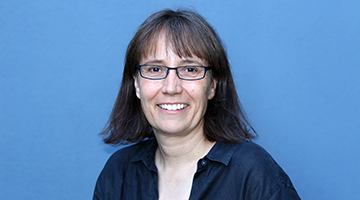 Senior scientist Elke Arenholz has seen a lot of changes at Beamlines 4.0.2 and 6.3.1 since she arrived at the ALS in 2000, but what brought her here initially is still what keeps her passionate about her work—designing new instrumentation and working with the user community to optimize research capabilities.
Senior scientist Elke Arenholz has seen a lot of changes at Beamlines 4.0.2 and 6.3.1 since she arrived at the ALS in 2000, but what brought her here initially is still what keeps her passionate about her work—designing new instrumentation and working with the user community to optimize research capabilities.
Arenholz’s first big project at the ALS ended up becoming her “claim to fame”—an eight pole electromagnet that provides magnetic fields up to 0.8 T in arbitrary directions relative to the incoming x-ray beam.
“It was really exciting to build and it had a huge impact right away because we were able to use it characterize materials in a way that no one had before,” says Arenholz. “It was the first device installed at a synchrotron that could apply the magnetic field in any direction, instead of just having it parallel to the x ray beam.”
Arenholz has continued with this theme ever since, always asking: “How can we extract some new information?” Typically, the answer involves working with engineering to create a new experimental configuration.
“I want to understand very fundamentally the interaction of x-rays with magnetic materials, and to do that I build new systems that people haven’t used before,” says Arenholz. “It’s a lot of fun, and we are really lucky to have a wonderful engineering department here at the Lab with lots of experts.”
In 2011, her group, which includes Beamline Scientists Catherine Jenkins and Padraic Shafer, completed work on a first-of-its-kind, ARRA-funded superconducting vector magnet. The magnet, which is a superconducting version of Arenholz’s eight pole electromagnet, provides fields up to 5 T in arbitrary directions.
Arenholz has focused on spectroscopy for much of her career, but she has recently turned her attention to scattering—studying x ray diffraction patterns from periodic structures on the nanoscale. Once again, this shift required building a new endstation. The LDRD-funded system that was installed at Beamline 4.0.2 last fall uses a superconducting disc of 0.8” diameter to generate 4 T at the sample while still allowing maximum flexibility for the scattering geometry.
While Arenholz enjoys her own research and the continual process of advancing beamline and endstation capabilities, she also finds her interactions with users at the beamline very rewarding. She describes her work life as consisting of two experiments—the scientific ones and the anthropological experiment of working with users.
“There’s a lot of teaching involved,” says Arenholz. “I am constantly thinking ‘How can I explain things better to users and make the system operation easier so that they make the best use of the experimental capabilities and beamtime?’”
In addition to her work at the ALS, Arenholz is an academic editor for AIP Advances, on the editorial board of the Journal of Magnetism and Magnetic Materials (JMMM), and program co-chair for the 2013 Joint MMM/Intermag Conference.